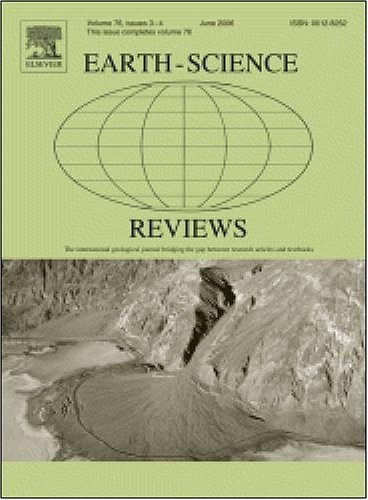从单一岩基到全球碎屑锆石档案:从锆石Eu异常看地球动力学
IF 10
1区 地球科学
Q1 GEOSCIENCES, MULTIDISCIPLINARY
引用次数: 0
摘要
由于大陆地壳的不断改造和与早期地球相关的有限岩石记录,研究地球大陆地壳的长期演化主要使用具有物理和化学抗性的矿物锆石。特别是铕异常[Eu/Eu* = EuN/(SmN × GdN)0.5;其中下标N表示球粒陨石归一化]的碎屑锆石种群已被提出作为追踪地壳厚度演化的可靠代理。然而,近年来的研究使得利用锆石Eu异常进行地球动力学重建存在争议。为了对锆石Eu/Eu*的岩石学控制提供新的认识,我们首先回顾了阿尔卑斯山脉最大的第三纪侵入岩——阿达梅洛岩基的锆石档案和演化。阿达梅洛岩基是解释大陆弧岩浆成因和演化的最好例子之一。从已有的大量锆石档案来看,不同侵入超单元Eu/Eu*随年龄、fO2和εHf(t)的减小而减小,δ18O的增大而增大。将锆石Eu/Eu*换算成地壳厚度时,大多数幼花岗岩套的Eu/Eu*≈70 km与岩石记录和阿尔卑斯山脉众所周知的地球动力学演化不一致。当将大多数年轻长英质岩浆的全岩(La/Yb)N转换为地壳厚度时,也得到了类似的不匹配,因为它没有考虑到板块衍生交代因子对地幔楔源的影响。锆石Eu/Eu*明显减少(即Eu异常明显增加),主要受地壳热区变质沉积岩减缩同化作用增强的影响,在分异显著之前,不同侵入超单元之间没有明显的压降。这与石墨变质岩是南阿尔卑斯地区中下陆壳的重要组成部分相一致。在此基础上,我们回顾了整个地球历史上的碎屑锆石档案,并解释了锆石Eu/Eu*的变化主要受岩浆不依赖压力的氧化还原状态控制。从新太古代到中元古代,Eu/Eu*明显减少,反映了作为中下地壳重要组成部分的变质沉积物质的减少,越来越多地用于地壳改造和岩浆污染。这一演化过程与古元古代是有机碳异常高埋藏时期、变质作用T/P比值最高时期以及中元古代至新元古代早期地幔和地壳岩浆活动丰富的时期相一致。我们认为,约1 Ga的最小Eu/Eu*值不能用来支持中元古代造山静止的观点。在新元古代和显生宙,锆石Eu/Eu*显著增加,同时变质作用的T/P比值普遍降低,标志着以深、长、冷俯冲带和更多氧化岩浆形成为特征的现代板块构造的出现。本文章由计算机程序翻译,如有差异,请以英文原文为准。
From single batholith to global detrital zircon archive: Earth dynamics as seen from zircon Eu anomalies
Due to the continuous reworking of the continental crust and the limited rock record associated with the early Earth, the long-term evolution of the Earth's continental crust is mostly studied using the physically- and chemically-resistant mineral zircon. In particular, the europium anomaly [Eu/Eu* = EuN/(SmN x GdN)0.5; where the subscript N denotes chondrite-normalized] of detrital zircon populations has been proposed as a robust proxy for tracing the evolution of crustal thickness. However, recent studies have made the use of the zircon Eu anomaly for geodynamic reconstructions controversial. To provide new insights into the petrological controls on zircon Eu/Eu*, we first review the zircon archive and the evolution of the Adamello batholith, the largest Tertiary intrusion in the Alps and one of the best-studied examples for elucidating the genesis and evolution of continental arc magmas. From the existing extensive zircon archive, the Eu/Eu* in the different intrusive super-units decreases with decreasing age, fO2 and εHf(t), and increasing δ18O. When the Eu/Eu* of zircon is converted to crustal thickness, the values of ≈70 km obtained for the most juvenile granitoid suites are inconsistent with the rock record and with the well-known geodynamic evolution of the Alps. A similar mismatch is also obtained when the whole-rock (La/Yb)N of the most juvenile felsic magmas is converted to crustal thickness, because it does not take into account the effect of slab-derived metasomatic agents affecting the mantle wedge source. The marked decrease in zircon Eu/Eu* (i.e., the marked increase in the Eu anomaly) is primarily influenced by the increasing assimilation of reduced metasedimentary rocks in the crustal hot zone, before significant differentiation and without any significant pressure drop between the different intrusive super-units. This is consistent with graphitic metapelites being an important component of the mid to lower continental crust in the Southern Alps domain. Based on these results, we then review the detrital zircon archive throughout the Earth's history and interpret changes in zircon Eu/Eu* as mainly controlled by the pressure-independent redox state of magmas. We interpret the marked decrease in Eu/Eu* from the Neoarchean to the Mesoproterozoic as reflecting the increase in reduced metasedimentary material as an important component of the mid to lower crust, which was increasingly available for crustal reworking and magma contamination. This evolution is consistent with the Paleoproterozoic being a period of anomalously high burial of organic carbon and with the highest T/P ratios of metamorphism and the abundant mantle- and crustally-derived magmatism that characterized the Mesoproterozoic to early Neoproterozoic. In our opinion, the minimum Eu/Eu* at ca. 1 Ga cannot be used to support the view of orogenic quiescence in the mid-Proterozoic. The marked increase in zircon Eu/Eu* throughout the Neoproterozoic and Phanerozoic, accompanied by a concomitant general decrease in the T/P ratios of metamorphism, is indicative of the emergence of modern plate tectonics, characterized by deep, prolonged and cold subduction zones and the formation of more oxidized magmas.
求助全文
通过发布文献求助,成功后即可免费获取论文全文。
去求助
来源期刊

Earth-Science Reviews
地学-地球科学综合
CiteScore
21.70
自引率
5.80%
发文量
294
审稿时长
15.1 weeks
期刊介绍:
Covering a much wider field than the usual specialist journals, Earth Science Reviews publishes review articles dealing with all aspects of Earth Sciences, and is an important vehicle for allowing readers to see their particular interest related to the Earth Sciences as a whole.
 求助内容:
求助内容: 应助结果提醒方式:
应助结果提醒方式:


